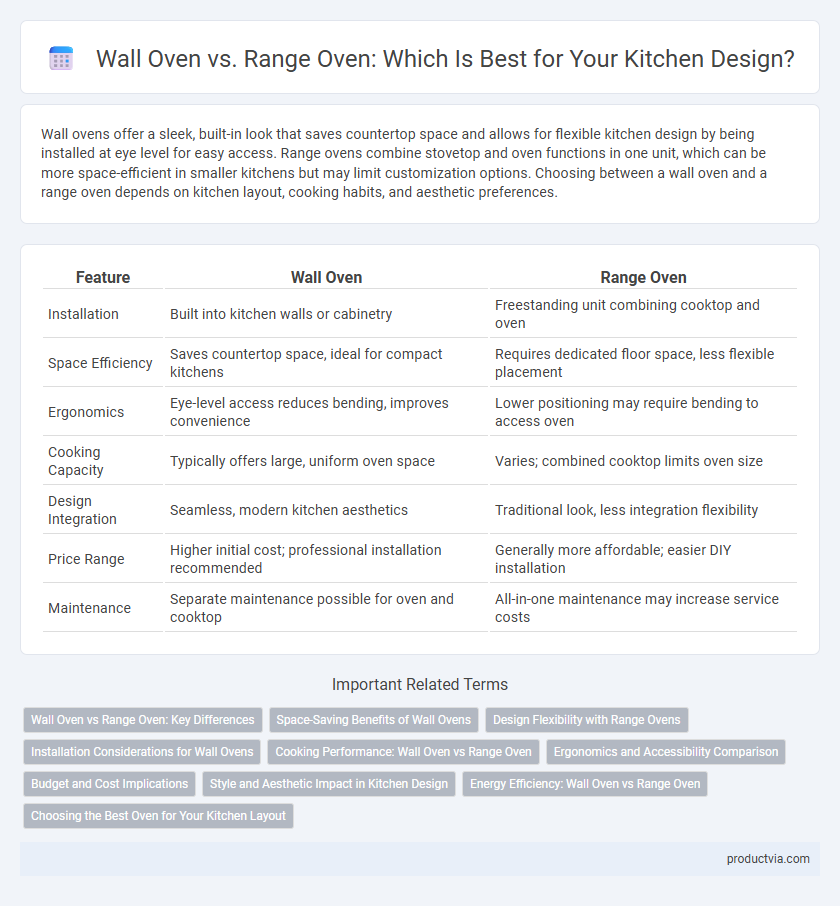Wall ovens offer a sleek, built-in look that saves countertop space and allows for flexible kitchen design by being installed at eye level for easy access. Range ovens combine stovetop and oven functions in one unit, which can be more space-efficient in smaller kitchens but may limit customization options. Choosing between a wall oven and a range oven depends on kitchen layout, cooking habits, and aesthetic preferences.
Table of Comparison
| Feature | Wall Oven | Range Oven |
|---|---|---|
| Installation | Built into kitchen walls or cabinetry | Freestanding unit combining cooktop and oven |
| Space Efficiency | Saves countertop space, ideal for compact kitchens | Requires dedicated floor space, less flexible placement |
| Ergonomics | Eye-level access reduces bending, improves convenience | Lower positioning may require bending to access oven |
| Cooking Capacity | Typically offers large, uniform oven space | Varies; combined cooktop limits oven size |
| Design Integration | Seamless, modern kitchen aesthetics | Traditional look, less integration flexibility |
| Price Range | Higher initial cost; professional installation recommended | Generally more affordable; easier DIY installation |
| Maintenance | Separate maintenance possible for oven and cooktop | All-in-one maintenance may increase service costs |
Wall Oven vs Range Oven: Key Differences
Wall ovens are built into cabinetry, offering streamlined kitchen design and freeing up floor space, while range ovens combine a cooktop and oven in one appliance, saving countertop space. Wall ovens provide flexible installation height for ergonomic cooking and typically feature advanced cooking technologies, whereas range ovens offer convenience and cost-effectiveness with combined stovetop and oven functions. Choosing between a wall oven and a range oven depends on kitchen layout, cooking preferences, and available space.
Space-Saving Benefits of Wall Ovens
Wall ovens maximize kitchen space by being built directly into cabinetry, freeing up countertop area and providing a streamlined, modern appearance. Their installation at eye level allows for easy access and safer handling of hot dishes compared to traditional range ovens. This space-efficient design is ideal for small kitchens or open floor plans seeking both functionality and aesthetic appeal.
Design Flexibility with Range Ovens
Range ovens offer superior design flexibility by combining the cooktop and oven into a single appliance, allowing for streamlined kitchen layouts and simplified installation. Unlike wall ovens that require dedicated cabinet space, range ovens fit seamlessly into standard countertop heights, making them ideal for smaller kitchens or those seeking a more integrated look. This flexibility supports diverse kitchen designs, from traditional to modern, without compromising functionality or aesthetics.
Installation Considerations for Wall Ovens
Wall ovens require built-in cabinetry or designated wall space for installation, offering a streamlined and space-saving solution in kitchen design. Proper ventilation and adherence to electrical specifications, such as a dedicated 240-volt circuit, are essential for safe and efficient operation. Unlike range ovens, wall ovens allow for flexible placement at ergonomic heights, reducing the need for bending and enhancing accessibility.
Cooking Performance: Wall Oven vs Range Oven
Wall ovens provide precise temperature control and even heat distribution, making them ideal for baking and roasting with consistent results. Range ovens offer versatile cooking performance with integrated stovetop burners, allowing seamless transition between cooking methods for complex meal preparation. Choosing between a wall oven and range oven depends on kitchen space and preferred cooking style, as wall ovens often excel in specialized tasks while range ovens deliver multifunctionality.
Ergonomics and Accessibility Comparison
Wall ovens offer superior ergonomics by being installed at eye or waist level, reducing the need for bending and lifting heavy dishes, which enhances safety and accessibility, particularly for users with mobility challenges. Range ovens combine cooktop and oven functions in a single unit but often require users to bend or stoop into the lower oven compartment, potentially causing strain during frequent use. Designing a kitchen with a wall oven prioritizes ease of access and ergonomic comfort, making it a preferred choice in modern, inclusive kitchen layouts.
Budget and Cost Implications
Wall ovens generally involve higher upfront installation costs due to built-in cabinetry modifications, making them a pricier option compared to range ovens. Range ovens combine stove and oven in one unit, offering a more budget-friendly choice with easier installation and maintenance. Homeowners prioritizing cost-efficiency often prefer range ovens, while those focusing on kitchen aesthetics and space optimization may justify the additional expense of wall ovens.
Style and Aesthetic Impact in Kitchen Design
Wall ovens offer a sleek, integrated look that enhances modern kitchen design by saving countertop space and creating a streamlined aesthetic. In contrast, range ovens serve as a central focal point, combining cooktop and oven in a single unit that complements traditional or farmhouse styles. Choosing between a wall oven and a range oven significantly influences the kitchen's visual flow, cabinetry layout, and overall design harmony.
Energy Efficiency: Wall Oven vs Range Oven
Wall ovens generally offer higher energy efficiency by using separate cooking zones that allow for targeted heating, reducing overall energy consumption compared to range ovens. Range ovens typically require more energy due to the combined cooktop and oven unit, which can lead to heat loss and less precise temperature control. Choosing a wall oven can contribute to lower utility bills and a more sustainable kitchen design.
Choosing the Best Oven for Your Kitchen Layout
Wall ovens offer a sleek, space-saving solution ideal for kitchens with limited floor area, allowing for flexible countertop and cabinet configurations. Range ovens combine cooktop and oven in one unit, maximizing space efficiency in compact kitchens but requiring specific counter and cabinet arrangements. Choosing the best oven depends on kitchen size, workflow preferences, and design goals, with wall ovens providing streamlined accessibility and range ovens offering integrated cooking functionality.
Wall Oven vs Range Oven for Kitchen Design Infographic

 productvia.com
productvia.com